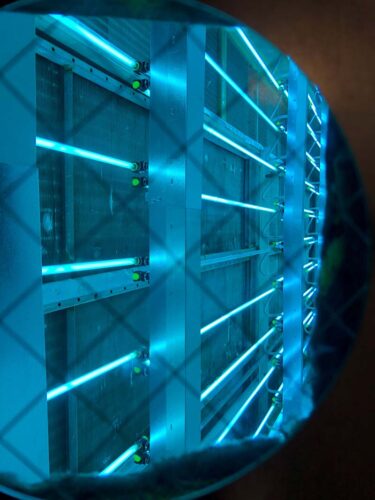In the age of environmental sustainability, energy efficiency isn’t just a buzzword – it’s a critical component of responsible business practice. With a multitude of technologies emerging to help commercial enterprises cut their energy usage, one of the most promising is Ultraviolet C (UVC) light technology. This powerful application of light not only aids in the eradication of harmful pathogens but can significantly lower the energy consumption of essential systems within commercial spaces. Let’s dive into how businesses can harness UVC technology to enhance their energy efficiency, reduce their environmental impact, and transform their bottom line.
Understanding UVC Technology and its Role in Energy Conservation

Ultraviolet (UV) light falls outside the visible light spectrum, and UVC specifically, with a wavelength of 200 to 280 nanometers, is known for its germicidal properties. When applied in the right manner, UVC light can kill or inactivate microorganisms by destroying nucleic acids and disrupting their DNA, effectively hindering their ability to replicate. But beyond its germ-fighting capabilities, UVC’s role in energy efficiency is gaining significant traction in the commercial sector.
The Science Behind UVC’s Impact on Energy Use
UVC technology works within systems like HVAC units, cooling towers, and refrigeration units to prevent the buildup of mold and other organic material that can reduce the efficiency of heat transfer elements. Through this maintenance of clear, clean surfaces, the systems work at their peak efficiency, translating into a significant reduction in energy consumption.
Benefits of UVC Technology in Enhancing Energy Efficiency
Lowering the Energy Bill: UVC’s Direct Impact
The most immediate and tangible result of UVC implementation is the direct reduction of electricity usage. When cooling and heating systems operate unobstructed by fouling agents, they require less power to accomplish the same level of thermal regulation.
UVC for Better Air Quality and Comfort
Clean air means better airflow, which in turn means more stable and consistent indoor temperature control. UVC helps maintain a comfortable environment while also contributing to the removal of harmful pathogens, which is especially crucial in the current climate.
Prolonged HVAC Equipment Lifespan
By minimizing the hindrances to heat transfer, UVC helps extend the life of vital equipment, reducing the need for premature system replacements and associated high energy costs.
Putting UVC to Work: Commercial Implementations and Successes
The use of UVC technology spans various applications in commercial buildings, and the success stories are multiplying. From hospitality to healthcare and office spaces, the potential for UVC to revolutionize energy efficiency is evident.
Integration into HVAC and Air Handling Units
UVC lamps are often installed in systems that move air, where they can have the most significant effect. By treating the air that passes through, UVC not only reduces microbial growth but keeps the system itself running optimally.
Cooling Tower Maintenance
Cooling towers are essential in many commercial settings, but they can be especially prone to microbial contamination. UVC installation here can cut down on energy use while reducing the need for manual cleaning, which is a labor-intensive and costly process.
Refrigeration: A Cool Energy Saver
UVC technology is also finding a place in commercial refrigeration, particularly in large-scale settings. By keeping evaporators and condensers free from the buildup that impedes heat transfer, UVC ensures that refrigeration systems operate efficiently with minimal energy expenditure.
Overcoming Challenges: Implementing UVC for Efficiency and Safety
While the potential benefits are substantial, there are considerations that businesses must address when integrating UVC technology into their energy-saving strategies.
Considering the Upfront Costs
The initial investment in UVC technology can be a roadblock for some businesses. However, the long-term savings and operational improvements can often justify the cost, especially as more affordable and efficient UVC products enter the market.
Compliance and Maintenance
Maintaining UVC systems is crucial for their continued performance and the safety of those working around them. Ensuring staff are trained and equipped to handle these systems is a must, as is adhering to best practices and regulations around UVC use.
Safety Concerns with UVC Exposure
Direct exposure to UVC light can be harmful, so it’s vital to take precautions when installing and maintaining UVC systems. Encasements and automatic shutoffs in systems designed for UVC use can mitigate these risks and build a safer work environment for all.
Peering into the Future: UVC Technology in Commercial Energy Efficiency
Emerging Applications and Systems
UVC innovations are expanding beyond traditional uses, opening doors for unexpected applications that could further transform the way we approach energy consumption and system maintenance in commercial spaces.
Moreover, UVC technology is part of a broader movement toward sustainable business solutions. As businesses continue to prioritize their environmental impact, we can expect UVC to play an increasingly pivotal role in their green initiatives.
Donnelly Mechanical Offers UVC Radiation Services
UVC technology is proving to be a game-changer for commercial entities looking to improve their energy efficiency — and at Donnelly Mechanical, we offer robust UVC options for your commercial business to explore. Whether there’s mold, bacteria, or viruses lingering, you can trust the professionals at Donnelly to remain in communication and rid your building of any airborne contaminants.
To learn how Donnelly can help, please visit our website and contact us today.